The ASUS ROG Strix GL502VS Review: Mainstream GTX 1070 with G-SYNC
by Brett Howse on December 9, 2016 8:00 AM ESTGPU Performance
The big update with the GL502VS over the previous model is NVIDIA’s new Pascal based GTX 1070, replacing the outgoing GTX 980M on the GL502VY. We’ve gone over this before when the GTX 10-series launched for notebooks, but this is a significant departure from previous mobile GPUs from NVIDIA. We’ve seen this coming over the years, with mobile GPUs and desktop GPUs being based on the same architecture, and the performance delta between them shrinking every year, but with the release of the 10-series, NVIDIA has dropped the M branding for mobile.
This doesn’t mean it’s the same GPU in a notebook as a desktop, but in NVIDIA’s eyes, the performance of the desktop and notebook part are close enough that they feel they can brand them the same. It also makes it easier for the consumer, because a GTX 1070 is a GTX 1070, more or less, when discussing performance, where as the GTX 980M was a pretty big step down from the GTX 980 (which did eventually find its way into high end gaming notebooks near the end of its life). The notebook version of the GTX 1070 is one of the most interesting of the bunch, since it actually has more CUDA cores than the desktop part, at 2048 compared to 1920 on the desktop. The core and boost clock are a bit lower than the desktop part, which means NVIDIA went for a bit of a wide and slow approach to meet their TDP goals, although that is all relative, since it’s far from slow.
The ASUS GL502VS was put through the notebook workload for GPUs, with a couple of new games added as well. To compare it to any other notebook we’ve tested, please use our online bench. First up is some synthetic tests, followed by gaming results.
3DMark
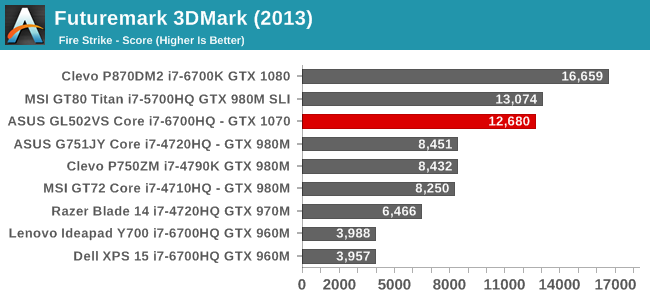
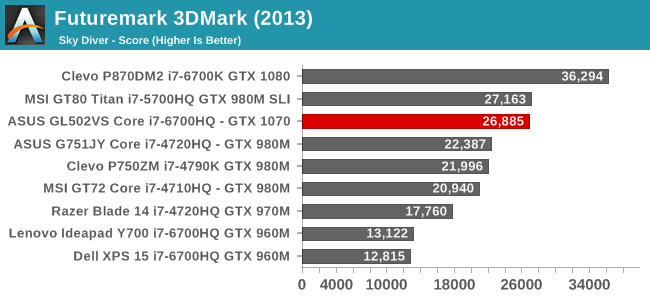
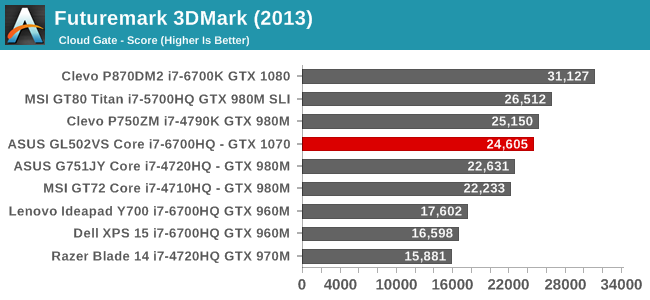
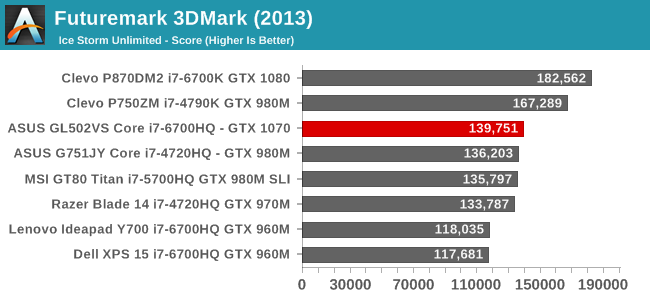
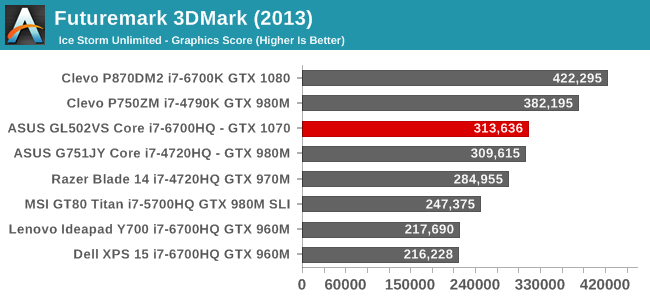
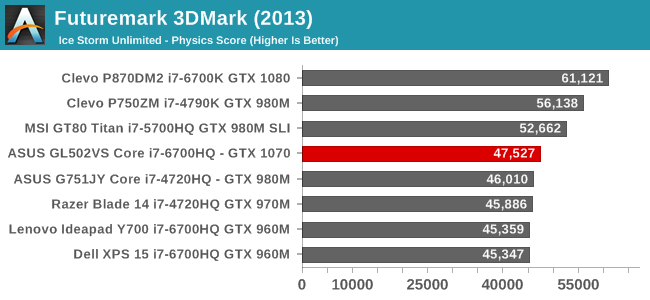
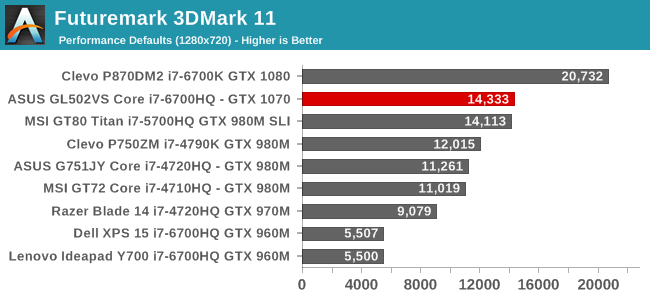
With the more difficult tests of Fire Strike and Sky Diver, the GTX 1070 is within spitting distance of the MSI GT80 Titan with SLI GTX 980M, showing just what a jump in performance the GTX 1070 is. One step under the GTX 1080, and there is still roughly the same performance as the best SLI laptop available with Maxwell. Not a bad start.
GFXBench
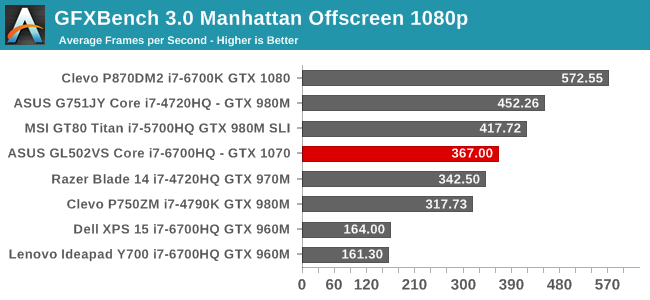
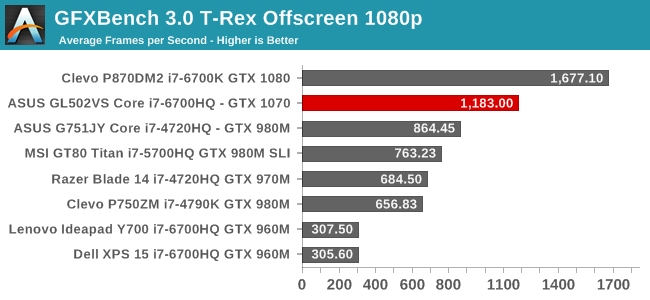
Both of the tests from the older version of GFXBench are really starting to show their age, with scores that are on the far side of ridiculous. The T-Rex scores are kind of insane for both of the Pascal laptops, with results well over 1000 frames per second. The latest version of the test includes some more difficult rendering, and this version will be the new default very soon.
Dota 2 Reborn
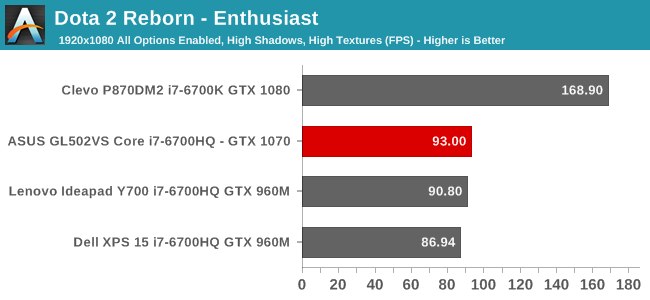
Valve updated the Dota 2 engine quite a while back now, and despite their best efforts, it is still largely a CPU bound test. The GTX 1070 would normally run laps around a GTX 960M, but they are within a couple frames per second of each other with the same CPU available, while the Clevo runs away with this test thanks to the inclusion of a desktop class 95-Watt processor.
Tomb Raider

Although several years old, with everything at maximum Tomb Raider can still be punishing to slower graphics processing units, but with the benefits of Pascal and a much more power efficient architecture, the ASUS GL502VS is once again right on the heels of the SLI GTX 980M found in the GT80 Titan. That seems to be a pretty consistent result, which is very impressive for a mid-range GPU.
Rise of the Tomb Raider

The latest version of Tomb Raider is a beautiful game to look at, especially with everything at maximum. The ASUS compares very well here, still averaging almost 100 frames per second. Be warned though, ASUS does offer a version of this laptop with a 4 GB GPU, and you need more than 4 GB of memory to run this game at its maximum settings, so be sure to future proof yourself with an 8 GB model.
Civilization VI



Although the game is new, the underlying engine is pretty much the same, and Civilization continues to be a mostly CPU bound game. Since the last review of the GTX 1080 Clevo, the benchmark has been updated and the scores from that system are no longer valid, so for the time being there is just a single result here, but as you can see there is very little difference between maximum settings and minimum, as far as frame rate. Interestingly they’ve also added a new test to determine the average amount of time between turns, and that should be useful for future reviews as a CPU test.
Bioshock Infinite
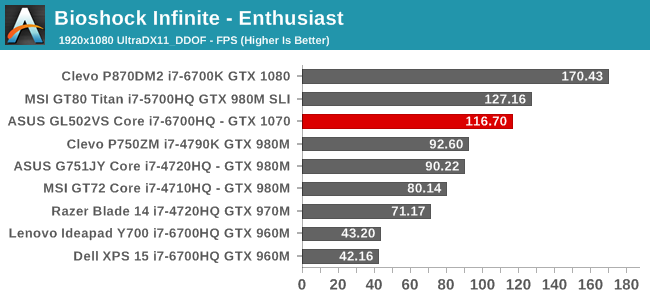
Once again this game is getting a bit old, but it’s still very fun, and can be quite demanding at maximum settings. Pascal is really taking this game for granted though, as even on the maximum settings the frame rate is still very high, and once again it is right behind SLI GTX 980M.
Dragon Age: Inquisition
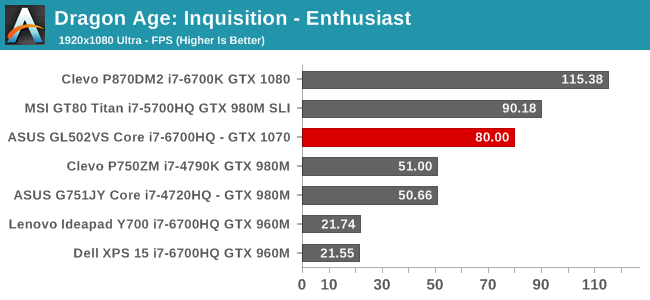
Although behind the GT80 Titan, the ASUS GL502VS is very much right up there when playing this amazing RPG from the end of 2014. There is a healthy step up from the GTX 980M, and the GTX 960M cards aren’t even playable at these settings.
Shadow of Mordor
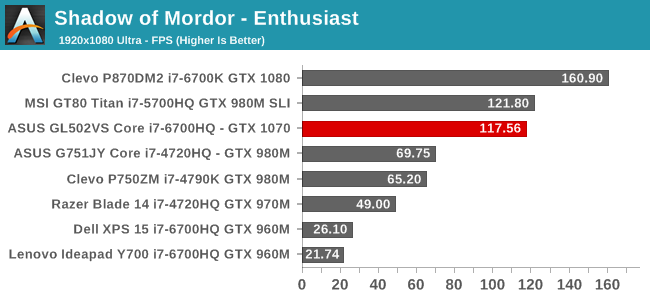
The theme continues, with the GTX 1070 only a hair behind the SLI gaming powerhouse from a year ago.
Grid Autosport
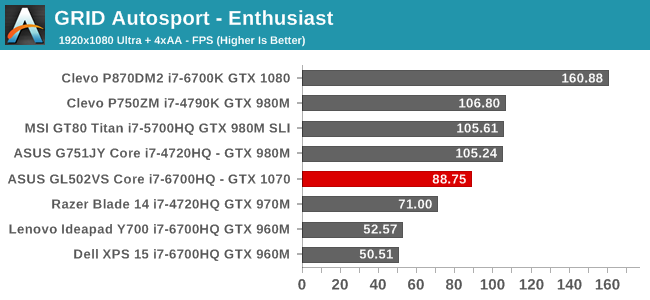
Here we see a bit of a role reversal, with the GTX 1070 falling slightly behind the GTX 980M. This game tends to be CPU bound though, and it’s likely a driver optimization issue here. Regardless, at almost 90 frames per second, it is still not a problem to play.
GPU Conclusion
Maxwell was a big launch for NVIDIA, and the GTX 980M continues to be a pretty powerful GPU, but with FinFET available, Pascal based cards are a huge jump in efficiency. It seems to be pretty consistent in the tests that the GTX 1070 was neck to neck with the SLI GTX 980M, while the GTX 1080 jumps clear of everything by a big margin. The step down to the GTX 1070 from the GTX 1080 is a decent sized step, but regardless the performance of the GTX 1070 is very impressive. Compared to a gaming laptop from a year ago, the ASUS GL502VS is basically on par with the fastest SLI laptops around which is quite an accomplishment.
Most of these games would be playable at UHD resolution (3840x2160) but some of the settings would have to be tweaked for better performance. There isn’t quite enough headroom like on the GTX 1080 to really go for UHD gaming. Just be sure to pick up the 8 GB graphics card to avoid issues in the future, since both a 4 GB and 8 GB model are available.










54 Comments
View All Comments
milkod2001 - Friday, December 9, 2016 - link
$1600 is not mainstream by all means but it has very decent specs that that price. It should last at least 3 years no probs. The only thing i would want to change is screen size, should have been 17''.Brett Howse - Sunday, December 11, 2016 - link
They do sell the GL702VM as a 17.3-inch model, but only with GTX 1060. ASUS has the GTX 1070 and up in the G752 which is a nice machine.BrokenCrayons - Friday, December 9, 2016 - link
Mainstream is different for everyone, but I agree that even on the low-end of its price spectrum that this laptop is absolutely not mainstream. However, I understand when you're a writer you're compelled to throw something out there that ultimately can end up the subject of unforseen debate. Let's try not to get overly hung up on it since, really, its as unimportant as calling a penguin a fish. The only thing that's changed is the label. Nothing fundamental about the squishy inside bits of the penguin are made different in doing so.SharpHawk - Friday, December 9, 2016 - link
No thermal data on the CPU?shelbystripes - Friday, December 9, 2016 - link
I got the GL502VM on sale from Amazon for a ridiculous $899 on Black Friday. At that price it's an utterly amazing system, and even at regular price is one of the cheapest Nvidia 10-series systems around, though I have some comments about its performance that this article fails to mention. The article makes it seem like it's just a GL502VS with a 1060 instead of a 1070, and that's not the case:1) The GL502VM doesn't come with G-Sync. At least, the lower end models don't.
2) The base model uses a quad-core i5, which is slightly slower, but more importantly lacks hyperthreading. I've found HT to historically not make a huge difference, but it's worth noting.
2) The GL502VM comes with 8GB RAM soldered on. It has one SODIMM slot, so if you buy a 16GB model it includes one 8GB DIMM plus the soldered-on RAM. Max memory capacity is limited to 24GB, since you can't swap out one channel of 8GB for 16GB later.
3) The GTX 1060 inside is the 3GB model, which actually has not just less RAM but fewer cores than the 6GB model. Still sufficient for 1080p gaming in a lot of games, especially for a budget gaming laptop, but worth noting it's about more than just the RAM. (I'm not sure if there's a similar discrepancy between the 4GB and 8GB GTX 1070 models available in the GL502VS, but at least you can get the higher end model there.)
4) This is really a comment on both machines, but the base models come with a mechanical HDD only. There's still an M.2 slot in the base models, it's just unpopulated. Still, I snagged a cheap 2.5" SATA SSD on Black Friday, and just a little simple surgery (not difficult, but 10 screws just to open it up, plus 8 screws for the HDD mount!) later, I had a MUCH faster system than I would have otherwise.
And lastly, a general tip when self-upgrading to save money: Windows 10 doesn't come with activation keys, it syncs your system unique ID to your Microsoft account. Microsoft made clean-installing Windows 10 much easier, you can download a tool from Microsoft's website to make a Windows 10 USB installer, but you'll need to boot the system at least once on the mechanical HDD to activate the copy of Windows 10 it comes with and link it to your Microsoft account. Then you can yank the HDD, swap in an SSD, and do a clean install (even if you're adding an M.2 SSD and keeping the HDD, you may want to do a clean install onto the SSD to get rid of the crapware anyway) without any problem. Just log into your Microsoft account during the reinstall and it'll recognize you have a Windows 10 license for that device. If (like me) you were clinging to Windows 7 on your last machine, I figure this knowledge might be new and useful to you.
sundragon - Friday, December 23, 2016 - link
Thank you! I may do this on my 502VS.label47 - Friday, December 9, 2016 - link
If you play heavy games the Battery will drain while plugged in...https://rog.asus.com/forum/showthread.php?88742-GL...
jsntech - Friday, December 9, 2016 - link
Yikes. Wonder what happens when it gets down to 0%? The ASUS rep responding to one of the bunches of people with the same complaint is unfortunate: " I've PM you a message, please check your inbox, thank you". Like they're trying to run interference instead of just openly acknowledging and working with customers. "Support" like that is one of the reasons I am hesitant to go with ASUS and others like them (though the bigger players are no better...sigh).kvnobrien - Friday, December 9, 2016 - link
"ASUS would have much better battery life if it just had a bigger battery" - quote of the year. Thank you this made me chuckle. I get the point you were trying to make it's just funny though.marco89nish - Friday, December 9, 2016 - link
I fail to see usefulness of G-Sync on 60Hz 1080p display with GTX 1070. It should be very challenging to drop 1070 to under 60 fps in next few years. Adding 75/90/120Hz display instead of G-Sync would yield much better value in my opinion.